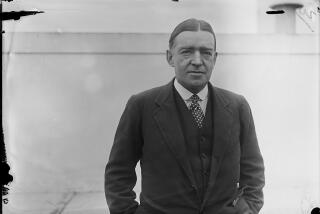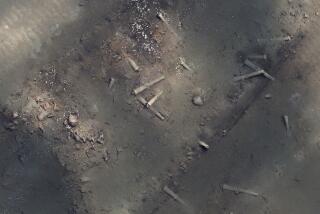Salvage Begins on $400-Million Treasure of 18th-Century Pirate
- Share via
CHATHAM, Mass. — Salvagers have begun work at the wreck of Black Sam Bellamy’s pirate ship the Whydah, which sank in 1717 with gold, ivory and jewels worth an estimated $400 million, a spokesman said Thursday.
Rob McClung of the salvage company Maritime Explorations said a crew had begun laying out grids on the ocean floor that will be used to map the wreck site by marking off the location of artifacts as they are retrieved.
“Ultimately what that will give us is a map of where things were on the bottom of the ocean,” McClung said. “That information may be relative to determining how the wreck landed.”
Sank in a Storm
The notorious Black Sam Bellamy died when the Whydah went down in a storm on Feb. 17, 1717, carrying about 200 pirates and treasure from raids on 52 other ships.
The Whydah and its booty of gold, silver, ivory and jewels is now buried off Wellfleet in 10 feet of sand, 30 feet below the ocean’s surface, where it was discovered in 1984. Its value has been placed as high as $400 million.
A small crew aboard the 70-foot ship the Vast Explorer began work at the site early this week and a larger ship, the Maritime Explorer, was expected to arrive soon with a 36-member crew, mostly divers.
McClung said the salvage team plans to first bring up the heavier objects--as many as 40 one-ton cannons, pieces of the ship’s rigging and a stove--and save the gold coins and jewels for last.
McClung said the rugged New England weather makes salvage work off Cape Cod seasonal, from early June through October. He said it could take another three seasons to complete excavation of the Whydah, which is being financed by E. F. Hutton & Co. Inc.
Treasure hunters working in deeper waters 85 miles away, south of Nantucket Island, are trying to beat the stormy season in their search of the sunken luxury liner Republic, believed laden with up to $1.6 billion in gold coins.
The Republic sank 280 feet to the ocean floor in 1909 after colliding with the Florida. A 46-man crew privately financed by Sub-Ocean Salvors of Tampa, Fla., has been at the site since late June.
More to Read
Sign up for Essential California
The most important California stories and recommendations in your inbox every morning.
You may occasionally receive promotional content from the Los Angeles Times.











